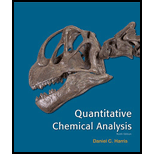
Interpretation:
The negative absorbance of all the peaks that obtained from ion-exchange chromatography in the study of decomposition of dithionite should be explained.
Ion-Exchange Chromatography:
Ion-Exchange Chromatography is separation technique, which is work in the principle of exchanging of ions based on attraction to the ion exchanger.
It contains two phases, one is stationary phase and another one is mobile phase.
In generally resins are act as a stationary phase, the positively charged ion exchangers attract solute anions and negatively charged ion exchangers are attract solute cations.
The higher polar eluent is passed through a column the exchangers are releases the solute and they will come out from the column.
In this process, the stationary phase (ion exchangers) is exchange the solute ions into eluent ions therefore it is called as Ion-exchange chromatography.
Indirect detection:
In the separation ions in ion-exchange chromatography, the separated anion or cation are detected by addition of substance which is have a steady background signal with the background electrolyte, the signal of the additional substance are remove from the chromatogram to give a signal of sample.
In this method the sample is detected by negative signals of additional substance so this is called as an indirect detection.
Want to see the full answer?
Check out a sample textbook solution
Chapter 26 Solutions
Quantitative Chemical Analysis
- 1. The following conversion includes chemistry we have covered very recently, some chemistry from last term, and chemistry from the first chapter of this unit. Provide curly arrows and an explanation for this mechanism. Use the reagents in the order given. You do not need any other reagents. 1. NaOEt OEt 2.arrow_forwardCOOEt COOEt Step 1 Step 2 Step 3 COOEt COOEt COOH Step 6 OH Step 4 Step 7 (racemic) cyclizes under conditions (8) OTS Step 5 Step 8 ОН OH (racemic) Frontalin (racemic) Shown above are the steps in one of the several published syntheses of Frontalin, a pheromone of the western pine beetle. From the choices provided, show the reagents and conditions by which step 3 of this synthesis might be accomplished. List the reagent(s) in order that will accomplish this transformation. No more than 4 steps are required. List your answer as a single letter (single-step transformation) or a series of letters (multi-step transformation) with no commas separating them. For example, "ab" corresponds to: 1. Eto Na+ 2. NaOH, H₂O NOTE: The order in which you list your letters matters! Reagents: a. Eto Na* g. NaCN b. NaOH, H₂O h. SOCI₂ c. H3O+, heat i. (CH3)2CuLi, ether, -78°C d. LiAlH4 j. H₂O e. p-TsCI, pyridine k. RCO3H f. Br I. H3O+ 1,024arrow_forwardK ← nationa Login - Paymentivet MapQue Draw the major product of this reaction. Ignore inorganic byproducts and the carboxylic acid side product. N 1. excess LiAlH4 2. H₂O ✓ W aarrow_forward
- Draw the major product of this reaction. Ignore inorganic byproducts and the alcohol side product. 1. H3O+, heat 2. Neutralizing work-up Drawing Qarrow_forwardIndicate the procedure (reagent Z) to go from compound A1 to compound A2. A1 Z P(C6H5)3 A2arrow_forwardPlease help with this graph.arrow_forward
- ogin - PaymentN MapQuest 3 Overview - SAP NetW... Draw the major product of this reaction. Ignore inorganic byproducts. CI 1. NaBH4 2. H₂O C Clever | Portal Job Op Problem Atoms, Bonds and Rings Draw or tap a new bond toarrow_forward2. Draw the remaining two resonance structures for the carbocation intermediate in the meta nitration of methyl benzoate AND explain why the meta orientation is preferred. Hint: how is the placement of the cation favorable after addition of nitronium relative to the electron withdrawing group? (2 pts) H NO2 CO₂Mearrow_forwardLabel all absorptions over 1500 cm-1. Please be specific and mark IR if needed for explanation. Compound OH sp^3 C-H C=O C-O Triglyceridearrow_forward
- Identify the intermediate that is INITIALLY formed in a saponification reaction (hydrolysis of an ester). III -OH H₂O HO OH HO O || A B C III D IV IVarrow_forwardHelp me answer this practice sheet I found for an answer guidearrow_forwardshow the retrosynthesis of this molecule step by step starting with 1,3-dimethoxy benzene H3CO OH OH OCH 3arrow_forward
 ChemistryChemistryISBN:9781305957404Author:Steven S. Zumdahl, Susan A. Zumdahl, Donald J. DeCostePublisher:Cengage Learning
ChemistryChemistryISBN:9781305957404Author:Steven S. Zumdahl, Susan A. Zumdahl, Donald J. DeCostePublisher:Cengage Learning ChemistryChemistryISBN:9781259911156Author:Raymond Chang Dr., Jason Overby ProfessorPublisher:McGraw-Hill Education
ChemistryChemistryISBN:9781259911156Author:Raymond Chang Dr., Jason Overby ProfessorPublisher:McGraw-Hill Education Principles of Instrumental AnalysisChemistryISBN:9781305577213Author:Douglas A. Skoog, F. James Holler, Stanley R. CrouchPublisher:Cengage Learning
Principles of Instrumental AnalysisChemistryISBN:9781305577213Author:Douglas A. Skoog, F. James Holler, Stanley R. CrouchPublisher:Cengage Learning Organic ChemistryChemistryISBN:9780078021558Author:Janice Gorzynski Smith Dr.Publisher:McGraw-Hill Education
Organic ChemistryChemistryISBN:9780078021558Author:Janice Gorzynski Smith Dr.Publisher:McGraw-Hill Education Chemistry: Principles and ReactionsChemistryISBN:9781305079373Author:William L. Masterton, Cecile N. HurleyPublisher:Cengage Learning
Chemistry: Principles and ReactionsChemistryISBN:9781305079373Author:William L. Masterton, Cecile N. HurleyPublisher:Cengage Learning Elementary Principles of Chemical Processes, Bind...ChemistryISBN:9781118431221Author:Richard M. Felder, Ronald W. Rousseau, Lisa G. BullardPublisher:WILEY
Elementary Principles of Chemical Processes, Bind...ChemistryISBN:9781118431221Author:Richard M. Felder, Ronald W. Rousseau, Lisa G. BullardPublisher:WILEY





